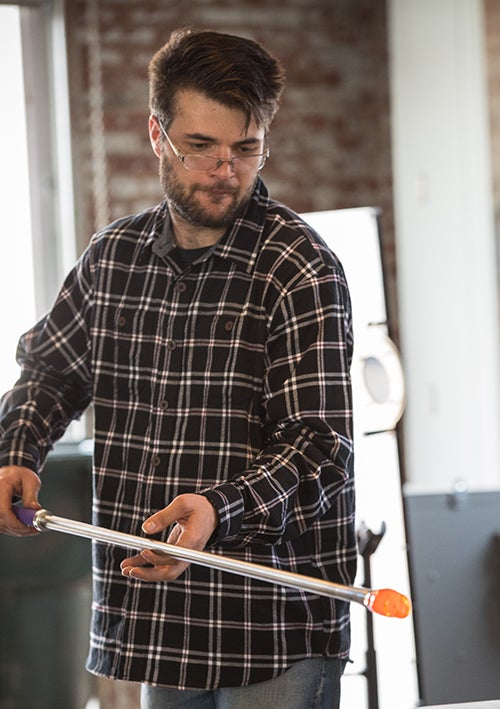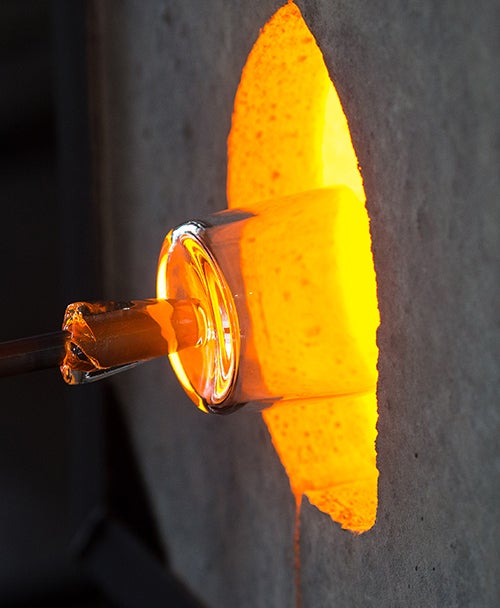Control the Heat
Students begin ECU's first glassblowing class
Five students are making history as the first enrolled in East Carolina University’s glassblowing class this spring in downtown Farmville.
Hand-blown glass is a new curriculum area for ECU and the only one in the UNC system, said Dr. Chris Buddo, dean of the ECU College of Fine Arts and Communication.
The School of Art and Design class is being held in the “GlasStation,” a nod to the building’s former life as a gas station on West Wilson Street. Built in 1946, the building features exposed brick, large windows and industrial light fixtures with about 2,400 square feet of studio space.

ECU’s class in Farmville – about 15 miles west of main campus – is the result of a grassroots effort by The Farmville Group, a volunteer economic development association interested in growing the local economy through the arts. The Allen and Stowe families donated the building to the DeVisconti Trust, which is leasing it to ECU for $14,000 a year plus utilities. ECU also purchased about $130,000 in equipment from North Carolina-based Wet Dog Glass.
Community leaders first contacted ECU in 2014 to talk about opening a studio or art gallery space as a way “to use art to breathe economic life into downtown,” Buddo said.
In response, ECU proposed a glass art facility that would not only serve as a classroom for students, but would become a destination for anyone interested in glassblowing. Hand-blown glass eventually could become a new concentration in the art school, Buddo said.
That’s also the vision for teaching instructor Michael Tracy, a glass and graphite artist originally from Virginia Beach, Virginia.
The art majors enrolled this semester are pursuing a mix of concentrations, from graphic and textile design to ceramics.
On an unseasonably warm February afternoon, the electric furnace that heats glass over 2,000 degrees also helped heat up the studio space where the students worked to make their first drinking glasses.
Using a long-handled metal rod, ECU senior Qattera Brown constantly moved her glass object from the fire to a specially-made bench where she rolled and cooled it before returning it to the fire. Another student blew into the end of the hollow rod, and the mix of air and heat helped to expand the glass on the other end. The process was repeated many times – including the use of a block, paddle and jack, which resemble large tongs – to manipulate and prevent the glass from collapsing or becoming misshapen.
“Ninety percent of glassblowing is controlling the heat,” Tracy told the students. “If you control the heat, you control the shape.”
It’s a choreographed process of heat, movement and pressure. “You don’t want anything to start cracking so you need to keep everything above 1,000 degrees,” Tracy said.
Tracy commended Brown on her glass. “This looks great,” he said. “I can’t believe this is your first one.”
Brown, a student in the graphic design concentration, said she’s never worked with glass before and didn’t know it was the first glassblowing class at ECU before signing up.

While glassblowing is coming to her easily, Brown said the hardest part was the constant rotation. “Because you have to try to keep rotating and you also have to maintain to make sure the glass doesn’t stay too hot and to make sure it’s not off balance, so to keep rotating to make sure all those things work perfectly is very difficult,” Brown said.
By the end of the semester, Brown said she wants to make something really nice for her mom – possibly a wine glass with a funky stem – and “make an A, of course.”
Textile design student Kim Brown said she wanted to “try glass because it looks really interesting. I think it’s important to learn more things and have new skills.”
Ronson Schultz, a first-year graduate student in ceramics, said glassblowing and ceramics have similar elements but the steps to a finished product are jumbled. “I’m accustomed to the heat, and starting at the foot,” he said. “But we’re starting hot as opposed to ending hot.”
The process for making glass and ceramics also are similar because “there’s a focus point you’re turning from,” said Lacey Hargroder, a first-year graduate student in ceramics.
Because of the equipment and space needed, Tracy can teach up to eight students per semester. Another class will be offered in the summer and fall, with continuing education courses for the community beginning in late March.
ECU has the largest studio art program in North Carolina. Curriculum areas include animation/interactive design, art education, art histories, ceramics, film and video production, graphic design, illustration, metal design, painting, photography, printmaking, sculpture and textile design.
For more information, visit www.ecu.edu/soad or email glass@ecu.edu.